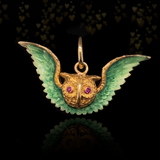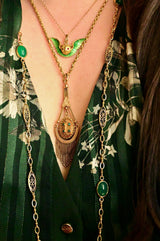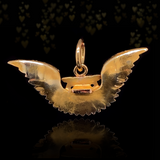Lace Jewels
14K Victorian Ruby Winged Owl Egyptian Revival Guilloche Enamel Pendant
An incredible and rare Victorian c.1890-1900 Egyptian revival winged owl pendant, modelled in 14k gold.
The owl is carved with fine craftsmanship, and set with two dazzling ruby eyes, approx. 0.06ctw. The wings are finely enamelled in guilloche enamel work that captures details of the owl's feathers.
It was a stick pin that has been masterfully converted into a wearable pendant.
Such Egyptian revival pieces often make their way into the hands of private collectors and are rarely seen available in the market. More importantly so, the condition of this piece is remarkable and near pristine, and would make a fabulous addition to any cherished antique enthusiast's collection.
It measures 33mm x 19mm with bail, 33mm x 15mm without bail, and weighs 3.82 grams. The owl's head is 8.5mm x 8.5mm height, and the wings are 33mm across.
Egyptian Revival in Victorian Era
"At the dawn of the nineteenth century, this new field of Egyptology spawned numerous archaeological expeditions to the region with the anticipation of treasure among the tombs of the Pharaohs. From 1859-1869, the Suez Canal was under construction and the French fascination for the project was so pervasive that the Paris Exposition of 1867 featured Egyptian-inspired jewels from Boucheron, Mellerio, Baugrand, and others. Empress Eugénie herself (wife of Napoléon III) requested jewels in the Egyptian taste from her court jeweler, Lemonnier (most famously an aigrette with a lotus flower and bird’s wings). The thirst for Egyptian-themed jewels soon spread across the continent and jewelers such as Giuliano, Castellani, and Fontenay included some Egyptian revival jewels alongside their other archaeological and revival styles.
Continued exploration of the region and amazing discoveries kept Egyptomania in full swing throughout the early part of the twentieth century. Gaston Maspero opened the temples at Karnak, Edward Ayrton found a royal tomb at Thebes in 1908, and Borchardt found the bust of Nefertiti c.1912, to name a few. Spurred on by treasure dealers who came to Paris to ply their wares, antiquities were finding their way into collections around the world.
It is quite possible, by the sheer impetus of its popularity, that this fashion for Egyptian inspired jewels would have continued undimmed into the Art Deco period. A tremendous boost was added with Carter’s 1922 discovery of the tomb of King Tutankhamun, thereby ensuring its enduring demand. The treasures found in the boy king’s tomb propelled Egyptomania into full-fledged hysteria. The apex of the style was reached c.1929, the year of the Cairo Exhibition" - The entire above excerpt is provided by Antique Jewelry University / Lang Antiques. Click here for the page written by Lang Antiques about Egyptian Revival jewellery in the late 19th to early 20th century.
Era - Victorian c.1890-1900
Materials - 14k gold / Ruby / Enamel
Carat Weight - Ruby: 0.06ctw
Measurements - 33mm x 19mm with bail, 33mm x 15mm without bail






